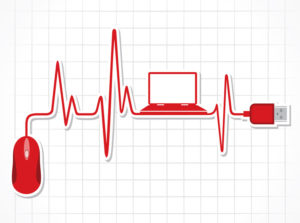Surveillance Monitoring: Current Challenges and Solutions
Examples of conventional patient-worn surveillance monitoring systems include Nihon Kohden’s NTX ZM-540/541P (http://us.nihonkohden.com/products/ntx-zm-540541p/), Sotera Wireless ViSi Mobile (http://www.soterawireless.com/visi-mobile/), and the Masimo Radius-7 (http://masimo.com/root/radius-7.htm).
Wireless sensor solutions leverage miniaturization and packaging, resulting in a single disposable or partially disposable unit that adheres to the patient’s skin. Some wireless sensor solutions are made up of two components with a wired connection. This two-component approach is often used to offset a particular physiological sensor to improve the effectiveness of that parameter.
These wireless sensor-based patient monitors are quick and easy to apply. Due to the sensors’ size, patients tolerate them well. The adhesive and battery are designed to support operational time frames on a par with average patient lengths of stay. Wireless sensors have no wires to come undone or to manage, and the designs often minimize motion artifacts that can result in false/positive alarms.
Wireless sensor solutions support a limited set of physiological parameters due to their size and preference for a single unit. Oblong-shaped packaging often contains a one- or two-lead ECG, and the sensors can measure parameters such as heart rate, RR interval, respiratory rate, and temperature; some include accelerometers to detect body posture, activity, and perhaps falls. Some wireless sensors take the “less is more” approach and track a single parameter, such as respiration. As with patient-worn monitors, wireless sensor solutions that include a reusable component may be lost. Some patients will have stays that exceed a sensor’s battery life and/or recommended adhesive tolerance, requiring the sensors to be replaced with new units.
The size and power consumption requirements for wireless sensors mean they often must use low-power radios with a short range, necessitating a gateway device that aggregates sensor data and conveys it to the enterprise network. Gateways may be patient-worn, representing yet another small device to deploy, manage, and retrieve at discharge. Alternatively, gateways can be mounted at the bedside or wherever sensor data is to be captured. The number of mounted gateways needed for an installation depends on the monitoring use case and patient mobility, and can represent a substantial portion of the cost of a surveillance monitoring solution.
Wireless sensor solutions are available from Vital Connect (http://www.vitalconnect.com), Philips (who apparently OEMs the Vital Connect device), and PMD Solutions (http://www.pmd-solutions.com). Other wireless sensor solutions targeting ambulatory and acute care are available from companies in the EU.
Remote sensing monitors
Technologies are available that capture patients’ vital signs data from a distance, although they don’t quite resemble the ubiquitous tricorders from Star Trek. Remote sensors are usually installed once on top of or below the bed’s mattress, measuring patient movement to discern parameters such as heart and respiratory rates of anyone placed in that bed. One solution includes an option for attaching a wired SpO2 sensor to the patient. The currently dominant technology for tracking patient movement is piezoelectric crystals, although other technologies have been shown to be effective as well. The remote sensors are connected to the patient monitor, which in turn is networked to a central station.
The primary advantage of remote sensing monitors is that they do not physically touch the patient in any way. Consequently, once they have been installed in a bed there is no time required for application to the patient or maintenance, and no complaints of discomfort.
Though remote sensing monitors are convenient and accepted by patients, they can only track a limited number of physiological parameters. Because the underlying technology measures physical movement, it cannot measure parameters like ECG, blood pressure, or temperature.
Remote sensing monitor solution providers include EarlySense (http://www.earlysense.com) and Hoana Medical (http://www.hoana.com). Hoana Medical’s solution is currently not commercially available.
Clinical decision support systems
Clinical decision support systems used in surveillance monitoring fall into two segments: early warning systems based on proprietary algorithms and visualization tools that depict changes in the patient’s condition. Detecting deterioration is a challenge because condition changes may be subtle. Researchers have collected many hours of patient data to identify the relationships between data and outcomes and create proprietary algorithms to signal deterioration. This process sometimes includes the development of visualization techniques to better express deterioration and its course.
A key challenge to wringing improved outcomes from rapid response teams is in process improvement. Provider organizations must determine when deterioration has begun and then reliably trigger a response that ensures an intervention. Surveillance monitoring solutions that only provide monitored data require provider organizations to determine deterioration signals and trigger a response based on policy, procedures, and training—good old-fashioned management. Clinical decision support systems intended for surveillance monitoring clearly identify indicators of deterioration. With these systems, triggering an intervention on a deteriorating patient is no longer an opinion, but rather a response to the systems’ unambiguous signal.

